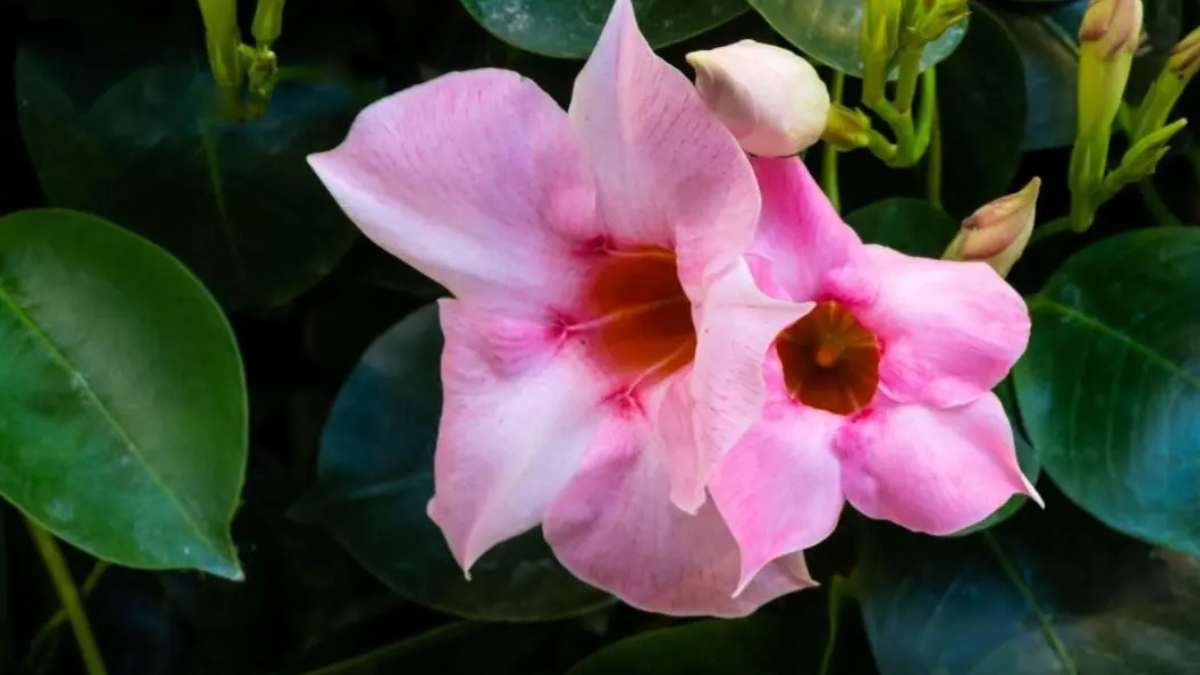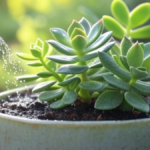How to Care Mandevilla Plant– involves giving the right amount of sunlight, moisture, and support for climbing. This tropical flowering vine is known for its trumpet-shaped blooms and can easily become the highlight of your garden or balcony if cared for properly.
I’ve been growing Mandevilla plants in both garden beds and large pots for the past few years. Based on my personal experience, it’s a rewarding plant that blooms beautifully when given the right care. In this post, I’ll share everything I’ve learned about growing Mandevilla successfully—from soil and watering to pruning and propagation.
IN THIS ARTICLE
About the Mandevilla Plant
| Feature | Details |
|---|---|
| Botanical Name | Mandevilla spp. |
| Common Names | Rock Trumpet, Dipladenia |
| Plant Type | Tropical flowering vine |
| Sunlight | Full sun to partial shade |
| Soil Type | Well-draining, rich organic mix |
| Blooming Season | Spring to early fall |
| Suitable For | Pots, garden beds, balcony, terrace |
| Propagation Method | Stem cuttings |
Quick Tips for How to Care Mandevilla Plant
- Use well-draining and fertile soil.
- Keep the plant in sunlight for at least 4–6 hours daily.
- Water when the topsoil becomes dry to the touch.
- Use organic or liquid fertilizer every 2–3 weeks.
- Provide a trellis or support for climbing.
- Prune regularly to promote new growth.
- Move indoors or protect during cold weather.
Watering Mandevilla Plant
Watering is crucial for Mandevilla, especially during summer.
- Water the plant when the top inch of soil feels dry.
- During hot weather, watering every 2–3 days is usually required.
- Avoid waterlogging the soil as it can cause root rot.
- If growing in pots, ensure proper drainage holes.
- In winter, reduce the watering frequency as the plant goes semi-dormant.
In my experience, underwatering causes leaves to wilt quickly, while overwatering leads to yellowing leaves. Keep the balance and monitor the moisture regularly.
Best Soil for Mandevilla
Mandevilla needs soil that retains moisture but drains well.
- Prepare a mix of:
- 50% garden soil or potting mix
- 25% compost or cow dung manure
- 25% perlite or coarse sand
- Avoid using heavy clay soil.
- If buying ready mix, choose one labeled for flowering or tropical plants.
I’ve seen the best growth when I mix compost and perlite in equal parts with garden soil. It helps retain nutrients while ensuring air circulation around the roots.
Sunlight Requirements
Sunlight plays a key role in blooming.
- Place the plant in a spot that receives 4–6 hours of bright light.
- Full morning sun and partial afternoon shade work best in hot regions.
- In low light, the plant may survive but will produce fewer flowers.
- For balcony growers, a south or west-facing balcony is ideal.
My Mandevilla blooms best when placed in morning sunlight and gets filtered light during peak heat hours.
Humidity and Temperature
Being a tropical plant, Mandevilla prefers warm and humid conditions.
- Ideal temperature: 18°C to 30°C (65°F to 86°F)
- Cannot tolerate frost or cold drafts
- Humidity should be moderate to high
- In cold regions, bring the plant indoors during winter or cover it well.
I usually bring my potted Mandevilla inside near a window during winter to prevent cold damage.
Fertilizer for Mandevilla
Feeding the plant helps it produce lush foliage and continuous flowers.
- Use a balanced liquid fertilizer (10-10-10 or 20-20-20) every 2–3 weeks during the growing season.
- Apply organic compost once a month to keep the soil fertile.
- Avoid high-nitrogen fertilizers that promote more leaves than flowers.
- Stop fertilizing during winter.
In my garden, I prefer using liquid seaweed extract along with homemade compost, which keeps the plant healthy and blooming.
Pruning and Maintenance
Regular pruning helps maintain shape and encourages new flowers.
- Cut back long or weak vines to stimulate bushier growth.
- Remove yellow, dry, or dead leaves from time to time.
- Major pruning should be done in early spring before new growth starts.
- Use clean, sharp tools to avoid plant infections.
Don’t be afraid to prune. The plant recovers quickly and looks even better.
How to Propagate Mandevilla
Propagation by stem cutting is simple and successful in most cases.
Steps for Propagation:
- Take a 4 to 6-inch cutting from a healthy stem.
- Remove lower leaves, keeping at least 2–3 nodes.
- Dip the end in rooting hormone powder (optional).
- Plant in a moist potting mix, not deep.
- Cover the pot with a plastic bag to create humidity.
- Keep the cutting in bright but indirect light.
- Roots will appear in about 2–3 weeks.
I’ve had the best success when propagating in early summer.
Common Problems and Solutions
| Problem | Cause | Solution |
|---|---|---|
| Yellow leaves | Overwatering, poor soil | Improve drainage, reduce watering |
| No flowers | Low light, poor feeding | Move to sunlight, use flowering feed |
| Pests (aphids etc.) | Poor airflow or weak plant | Use neem oil spray or insecticidal soap |
| Drooping vines | Underwatering or root rot | Water consistently, check root health |
From my experience, most issues arise from improper watering and low light. Once those are fixed, the plant bounces back quickly.
Conclusion Mandevilla Plant Care
Caring for a Mandevilla plant is quite easy once you understand its basic needs. With bright sunlight, rich soil, and consistent watering, the plant rewards you with vibrant, trumpet-shaped blooms that last all season. Based on my hands-on gardening experience, Mandevilla is a perfect choice for those who want a flowering vine with a tropical look.
If you want to enjoy colorful flowers on your terrace, balcony, or garden wall, Mandevilla is definitely worth growing. Just give it a little attention and the right environment—it will surely flourish











